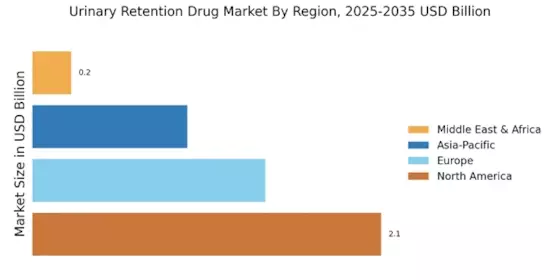Increasing Aging Population
The increasing aging population is a notable driver for the Urinary Retention Drug Market. As individuals age, they often experience various urinary disorders, including urinary retention. This demographic shift is projected to lead to a higher demand for effective treatment options. According to recent estimates, the population aged 65 and older is expected to reach approximately 1.5 billion by 2050, which could significantly impact the Urinary Retention Drug Market. The growing prevalence of age-related conditions, such as benign prostatic hyperplasia in men and pelvic floor disorders in women, further exacerbates the need for innovative drug solutions. Consequently, pharmaceutical companies are likely to focus on developing targeted therapies to address these specific needs, thereby driving market growth.
Rising Awareness and Diagnosis
Rising awareness regarding urinary disorders and their associated symptoms is contributing to the growth of the Urinary Retention Drug Market. Increased public health campaigns and educational initiatives have led to a greater understanding of urinary retention, prompting individuals to seek medical advice. This heightened awareness is reflected in the rising diagnosis rates of urinary retention, which has been reported to affect millions worldwide. As healthcare providers become more vigilant in identifying urinary disorders, the demand for effective pharmacological treatments is expected to rise. Furthermore, advancements in diagnostic technologies may facilitate earlier detection, thereby increasing the patient population requiring intervention. This trend suggests a robust growth trajectory for the Urinary Retention Drug Market as more patients are identified and treated.
Regulatory Support for Drug Approvals
Regulatory support for drug approvals is a pivotal factor influencing the Urinary Retention Drug Market. Regulatory agencies are increasingly recognizing the need for effective treatments for urinary disorders, leading to streamlined approval processes for new drugs. This supportive environment encourages pharmaceutical companies to invest in research and development, fostering innovation within the market. Recent initiatives aimed at expediting the approval of drugs for rare and underserved conditions may also benefit the Urinary Retention Drug Market. As more drugs receive regulatory approval, the availability of treatment options for urinary retention is expected to expand, ultimately enhancing patient access to necessary therapies. This trend indicates a positive outlook for the market as it adapts to meet the evolving needs of patients.
Growing Incidence of Neurological Disorders
The growing incidence of neurological disorders is emerging as a significant driver for the Urinary Retention Drug Market. Conditions such as multiple sclerosis, spinal cord injuries, and stroke can lead to urinary retention due to disrupted nerve signals. As the prevalence of these disorders increases, so does the demand for effective pharmacological interventions. Recent studies indicate that neurological conditions are on the rise, with millions affected globally. This trend underscores the necessity for targeted treatments that can alleviate urinary retention symptoms associated with these disorders. Pharmaceutical companies are likely to invest in research and development to create specialized drugs that cater to this patient population, thereby propelling the growth of the Urinary Retention Drug Market.
Technological Advancements in Drug Development
Technological advancements in drug development are playing a crucial role in shaping the Urinary Retention Drug Market. Innovations in drug formulation and delivery systems have led to the creation of more effective and patient-friendly treatment options. For instance, the development of extended-release formulations allows for improved patient compliance and better management of urinary retention symptoms. Additionally, the integration of biotechnology in drug development has enabled the creation of targeted therapies that address the underlying causes of urinary retention. As research continues to evolve, the introduction of novel compounds and treatment modalities is anticipated to enhance the therapeutic landscape. This dynamic environment is likely to attract investment and drive competition within the Urinary Retention Drug Market, ultimately benefiting patients.


















Leave a Comment